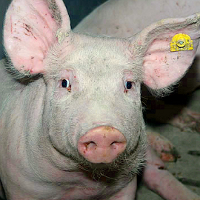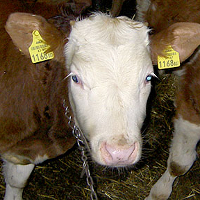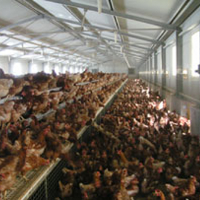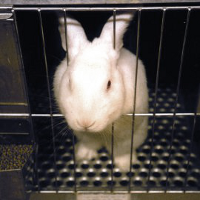
Why animal rights?
Pigs
 Five and a half million pigs are killed in Austria every year. Tightly crammed together in unstructured concrete pens, each pig has as little as 0.7 square metres. They are made to live above their own waste, which drops down through the slatted flooring of the pens. The ammonia polluted air is hard to breathe. After six months they are loaded onto a lorry and taken to be slaughtered.
Five and a half million pigs are killed in Austria every year. Tightly crammed together in unstructured concrete pens, each pig has as little as 0.7 square metres. They are made to live above their own waste, which drops down through the slatted flooring of the pens. The ammonia polluted air is hard to breathe. After six months they are loaded onto a lorry and taken to be slaughtered.
Male piglets are castrated during their first seven days. It is still permitted to carry out this surgical procedure without any anaesthetic! Female breeding pigs are artificially fertilized twice a year. Until recently, these pigs were kept for their entire life in gestation crates, which are body-sized cages. Now it has been ruled that they should at least be kept in groups during pregnancy. But for the duration of the birth and suckling of their piglets, they remain permanently confined in these cages.
Cattle
 Just like every other mammal, including us humans, the reason that cows produce milk is in order to nourish their babies. But the majority of cows alive today are used for another purpose. They have been selectively bred to produce high yields of milk – twice the amount that they produced 50 years ago. This over-production takes its toll on the cow's body, resulting in illness and earlier death. After being artificially fertilized, a cow will give birth to her calf nine months later. But they will mostly be separated from each other on the very first day so that the mother's milk can be used for people. Following a short fattening period, the calf will go for slaughter.
Just like every other mammal, including us humans, the reason that cows produce milk is in order to nourish their babies. But the majority of cows alive today are used for another purpose. They have been selectively bred to produce high yields of milk – twice the amount that they produced 50 years ago. This over-production takes its toll on the cow's body, resulting in illness and earlier death. After being artificially fertilized, a cow will give birth to her calf nine months later. But they will mostly be separated from each other on the very first day so that the mother's milk can be used for people. Following a short fattening period, the calf will go for slaughter.
Broiler chickens
 Today's broilers grow from chicks into chickens with a weight of 2kg in about one month. Selective breeding has been concentrated on rapid muscle growth, the part of the chicken eaten as meat. The animals' bones are unable to support this rate of growth in body weight - 30% of chickens arriving at slaughter have broken bones.
Today's broilers grow from chicks into chickens with a weight of 2kg in about one month. Selective breeding has been concentrated on rapid muscle growth, the part of the chicken eaten as meat. The animals' bones are unable to support this rate of growth in body weight - 30% of chickens arriving at slaughter have broken bones.
It is currently allowed to keep 20 broilers or 15 turkeys in a space measuring 1m². The poultry industry wants to get this stocking density increased so that even more animals can be packed together with no increase in space.
Laying hens
 For economical reasons around 9 million male chicks are gassed or crushed on their first day of life in Austria every year. Fattening these birds for their meat, who have been selectively bred for a high egg yield, just isn't profitable. The females are distributed as laying hens, and end up in free-range, barn or battery farming systems. Although battery farming was outlawed in Austria in 2005, eggs from battery farms are unfortunately still imported. They can be found mainly as ingredients in products such as pasta or cakes and biscuits, where no declaration is necessary about how the eggs have been farmed.
For economical reasons around 9 million male chicks are gassed or crushed on their first day of life in Austria every year. Fattening these birds for their meat, who have been selectively bred for a high egg yield, just isn't profitable. The females are distributed as laying hens, and end up in free-range, barn or battery farming systems. Although battery farming was outlawed in Austria in 2005, eggs from battery farms are unfortunately still imported. They can be found mainly as ingredients in products such as pasta or cakes and biscuits, where no declaration is necessary about how the eggs have been farmed.
Vivisection
 Approximately 200,000 animals are killed every year in animal experiments in Austria. Due to the fact that they reproduce quickly and are cheap to keep, over 80% of these animals are mice, rabbits and rats. But dogs and cats are also used in tests. Most of the experiments done are registered as basic research. They are not carried out to serve any particular purpose, but rather to gain general knowledge. In the name of science, around a third of lab' animals are killed out of sheer curiosity.
Approximately 200,000 animals are killed every year in animal experiments in Austria. Due to the fact that they reproduce quickly and are cheap to keep, over 80% of these animals are mice, rabbits and rats. But dogs and cats are also used in tests. Most of the experiments done are registered as basic research. They are not carried out to serve any particular purpose, but rather to gain general knowledge. In the name of science, around a third of lab' animals are killed out of sheer curiosity.


